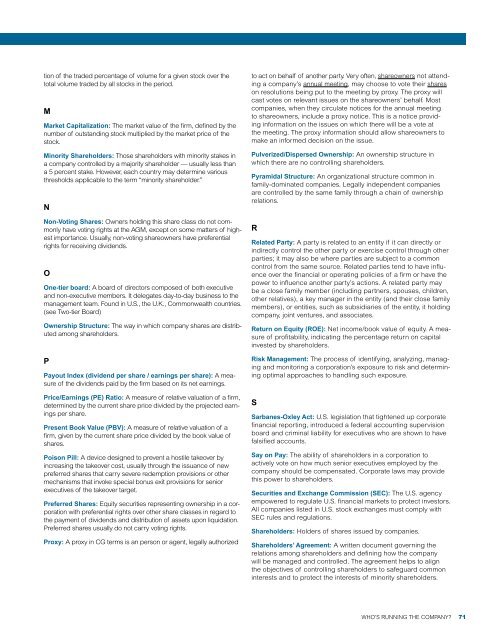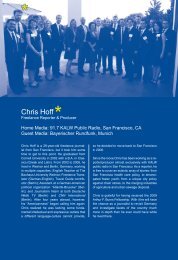Who's Running the Company? - International Center for Journalists
Who's Running the Company? - International Center for Journalists
Who's Running the Company? - International Center for Journalists
Create successful ePaper yourself
Turn your PDF publications into a flip-book with our unique Google optimized e-Paper software.
tion of <strong>the</strong> traded percentage of volume <strong>for</strong> a given stock over <strong>the</strong><br />
total volume traded by all stocks in <strong>the</strong> period.<br />
M<br />
Market Capitalization: The market value of <strong>the</strong> firm, defined by <strong>the</strong><br />
number of outstanding stock multiplied by <strong>the</strong> market price of <strong>the</strong><br />
stock.<br />
Minority Shareholders: Those shareholders with minority stakes in<br />
a company controlled by a majority shareholder — usually less than<br />
a 5 percent stake. However, each country may determine various<br />
thresholds applicable to <strong>the</strong> term “minority shareholder.”<br />
N<br />
Non-Voting Shares: Owners holding this share class do not commonly<br />
have voting rights at <strong>the</strong> AGM, except on some matters of highest<br />
importance. Usually, non-voting shareowners have preferential<br />
rights <strong>for</strong> receiving dividends.<br />
O<br />
One-tier board: A board of directors composed of both executive<br />
and non-executive members. It delegates day-to-day business to <strong>the</strong><br />
management team. Found in U.S., <strong>the</strong> U.K., Commonwealth countries.<br />
(see Two-tier Board)<br />
Ownership Structure: The way in which company shares are distributed<br />
among shareholders.<br />
P<br />
Payout Index (dividend per share / earnings per share): A measure<br />
of <strong>the</strong> dividends paid by <strong>the</strong> firm based on its net earnings.<br />
Price/Earnings (PE) Ratio: A measure of relative valuation of a firm,<br />
determined by <strong>the</strong> current share price divided by <strong>the</strong> projected earnings<br />
per share.<br />
Present Book Value (PBV): A measure of relative valuation of a<br />
firm, given by <strong>the</strong> current share price divided by <strong>the</strong> book value of<br />
shares.<br />
Poison Pill: A device designed to prevent a hostile takeover by<br />
increasing <strong>the</strong> takeover cost, usually through <strong>the</strong> issuance of new<br />
preferred shares that carry severe redemption provisions or o<strong>the</strong>r<br />
mechanisms that invoke special bonus exit provisions <strong>for</strong> senior<br />
executives of <strong>the</strong> takeover target.<br />
Preferred Shares: Equity securities representing ownership in a corporation<br />
with preferential rights over o<strong>the</strong>r share classes in regard to<br />
<strong>the</strong> payment of dividends and distribution of assets upon liquidation.<br />
Preferred shares usually do not carry voting rights.<br />
Proxy: A proxy in CG terms is an person or agent, legally authorized<br />
to act on behalf of ano<strong>the</strong>r party. Very often, shareowners not attending<br />
a company’s annual meeting, may choose to vote <strong>the</strong>ir shares<br />
on resolutions being put to <strong>the</strong> meeting by proxy. The proxy will<br />
cast votes on relevant issues on <strong>the</strong> shareowners’ behalf. Most<br />
companies, when <strong>the</strong>y circulate notices <strong>for</strong> <strong>the</strong> annual meeting<br />
to shareowners, include a proxy notice. This is a notice providing<br />
in<strong>for</strong>mation on <strong>the</strong> issues on which <strong>the</strong>re will be a vote at<br />
<strong>the</strong> meeting. The proxy in<strong>for</strong>mation should allow shareowners to<br />
make an in<strong>for</strong>med decision on <strong>the</strong> issue.<br />
Pulverized/Dispersed Ownership: An ownership structure in<br />
which <strong>the</strong>re are no controlling shareholders.<br />
Pyramidal Structure: An organizational structure common in<br />
family-dominated companies. Legally independent companies<br />
are controlled by <strong>the</strong> same family through a chain of ownership<br />
relations.<br />
R<br />
Related Party: A party is related to an entity if it can directly or<br />
indirectly control <strong>the</strong> o<strong>the</strong>r party or exercise control through o<strong>the</strong>r<br />
parties; it may also be where parties are subject to a common<br />
control from <strong>the</strong> same source. Related parties tend to have influence<br />
over <strong>the</strong> financial or operating policies of a firm or have <strong>the</strong><br />
power to influence ano<strong>the</strong>r party’s actions. A related party may<br />
be a close family member (including partners, spouses, children,<br />
o<strong>the</strong>r relatives), a key manager in <strong>the</strong> entity (and <strong>the</strong>ir close family<br />
members), or entities, such as subsidiaries of <strong>the</strong> entity, it holding<br />
company, joint ventures, and associates.<br />
Return on Equity (ROE): Net income/book value of equity. A measure<br />
of profitability, indicating <strong>the</strong> percentage return on capital<br />
invested by shareholders.<br />
Risk Management: The process of identifying, analyzing, managing<br />
and monitoring a corporation’s exposure to risk and determining<br />
optimal approaches to handling such exposure.<br />
S<br />
Sarbanes-Oxley Act: U.S. legislation that tightened up corporate<br />
financial reporting, introduced a federal accounting supervision<br />
board and criminal liability <strong>for</strong> executives who are shown to have<br />
falsified accounts.<br />
Say on Pay: The ability of shareholders in a corporation to<br />
actively vote on how much senior executives employed by <strong>the</strong><br />
company should be compensated. Corporate laws may provide<br />
this power to shareholders.<br />
Securities and Exchange Commission (SEC): The U.S. agency<br />
empowered to regulate U.S. financial markets to protect investors.<br />
All companies listed in U.S. stock exchanges must comply with<br />
SEC rules and regulations.<br />
Shareholders: Holders of shares issued by companies.<br />
Shareholders’ Agreement: A written document governing <strong>the</strong><br />
relations among shareholders and defining how <strong>the</strong> company<br />
will be managed and controlled. The agreement helps to align<br />
<strong>the</strong> objectives of controlling shareholders to safeguard common<br />
interests and to protect <strong>the</strong> interests of minority shareholders.<br />
WHO’S RUNNING THE COMPANY?<br />
71
















